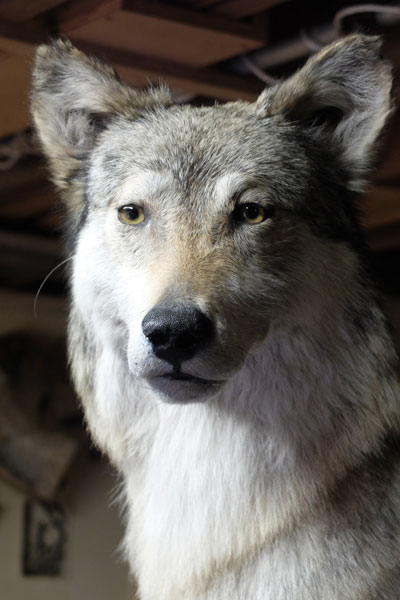
With Jean Ponzi
We have a very special guest in our home. This individual nurtured her kind back from the very brink of extinction.
She’s a Mexican gray wolf named Anna.
The humans who work at the Endangered Wolf Center tell Anna’s tale. They know it because she lived in their midst, right out in west St. Louis County. They learned from her and loved her – from a distance that respected her wild nature.
Anna was the only pup to survive from the pairing of two legendary wolves.
Santa Ana, her father, was one of the last pure Mexican wolves from the Ghost Ranch lineage. He was recovered after the species was declared extinct in the wild in 1980, making him the most genetically important animal of his species at the time. Her mother was Tanamara, of the McBride lineage. These mates were survivors in a critically endangered, native subspecies of gray wolf, animals whose social packs once thrived by the thousands in territory covering parts of Arizona, New Mexico, Texas and Mexico.
Anna was born on Earth Day, April 22, in 2001. Despite her efforts as a new mother, Tanamara lost two of three pups from this litter – the last sired by 13-year-old Santa Ana, who died later that year. The decision was made to hand-rear the third pup, Anna, knowing how crucial she was to recovery efforts for her species, tagged as the most endangered kind of wolf on Earth.
Little did anyone know just how important Anna would be.
Anna favored her magnificent father in her looks. She no doubt also inherited as much of her alpha instincts and pack leadership skills from her mother.
Because she had been hand-reared, Anna was not releasable in the wild. Still, her role in the wild is unmatched. She gave birth to 41 pups in four separate litters of record-breaking numbers. Several of her offspring now live in the wild. Others remain at the Endangered Wolf Center as part of their Saving a Species breeding program.
Anna’s extraordinary, productive life ended one day before her 14th birthday, last spring.
Why is she at my house? To continue Anna’s legacy, teaching about wolves, the Endangered Wolf Center has preserved her body as a taxidermy mount. My husband Dale, a woodworker with museum skills, was asked to work on the wooden base of the mount, at his studio, here.
Anna’s stay with us will be brief, but while she’s here I go into the studio often. I get to be with the physical form of one most beautiful being who literally turned the tide of life for her own kind. And whose relations now are reviving many more kinds of life as wild wolf populations are slowly re-growing. With much still-crucial human support.
Yellowstone National Park is just one of many examples of ecosystems that recovered from a tailspin once wolves were re-introduced after having been extinct in the park for decades. The park’s recovery can be seen throughout countless animal and plant species rebounding since reintroduction of this keystone predator. Biologists were hugely surprised as they observed this “trophic cascade” affecting animals, plants and the land.
Even dried-up streams flow again as the ecological balance held by Wolf returns.
As this Earth Day approaches, I give thanks for my opportunities to be useful. What a gift to be thankful both in my home and in the still, glorious presence of one who so deeply healed and wildly enriched Earth through her life.
Every Mexican gray wolf in the wild today can trace his or her roots back to the Endangered Wolf Center, Anna’s home, right here in St. Louis. Learn more about these efforts – and how you can visit and support the wolves – at www.endangeredwolfcenter.org.


